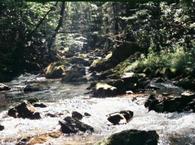
Little Black Caddis - Pupae
Although the Little Black Caddis hatch is a favorite of many because of its good dry fly fishing, you can catch more trout faster on an imitation of the pupae just before these caddisflies start to hatch on any given day. When you see a good number of them trying to get off the water, you may want to switch to a dry fly even though the pupa imitation will still produce better results. In the cold water these caddis usually hatch in, it takes a good amount of time for the adults to escape their pupae sheath or skin to dry their wings well enough to fly. I have seen times the adults couldn't even fly after they were out of the water and on the banks of the stream. This is common in the early mornings when the low nightly temperature has dropped down around the freezing mark. They become more active as the air warms during the day. Everything is dependant on the water and air temperatures.
You fish the pupae imitation like a wet fly down and across, instead of up or up and across. You should add a tiny amount of weight about 8 inches above the fly. We use a small BB size split-shot. Cast it up and across the fast water of a run or riffle and start mending the line (make two or three quick mends) when the fly first hits the water. This helps get the fly down. Let the fly swing all the way around in the current to the down and across position keeping snug contact with the fly or at least watching the end of the fly line closely for a take. When it is all the way around, hold the rod tip up at about a 45 degree angle and the fly will begin to surface due to the current. That's when the trout normally take the fly. Sometimes they take it when its almost all the way back to the surface. Let it sit on the surface a few seconds before repeating the presentation.





